| Cherapu, Button Mangosteen - Garcinia prainiana | |
|---|---|
 Fig. 1  Garcinia prainiana cross section 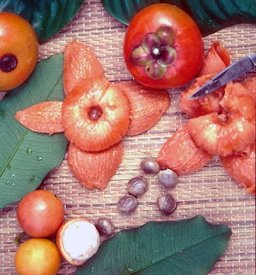 Fig.
2 Fig.
2  Button mangosteen 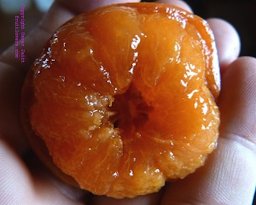 Fig. 3  G. Prainiana fruit interior 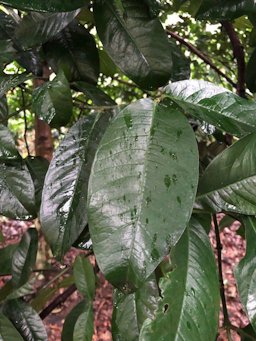 Fig. 4  G. prainiana. Malaysia. 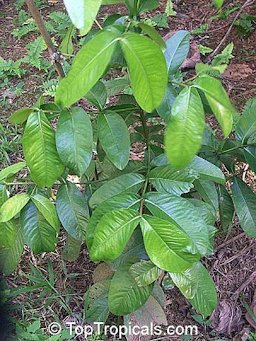 Fig. 5   Fig. 6   Fig. 7  Male flower which has the pollen 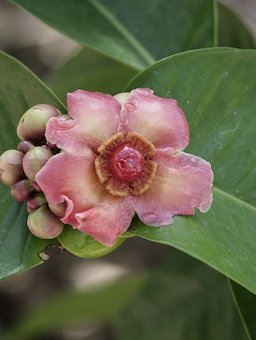 Fig. 8  G. prainiana flower cultivated, Fairchild Tropical Botanic Garden, Miami, Florida, USA. 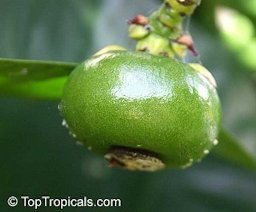 Fig. 9  Immature fruit 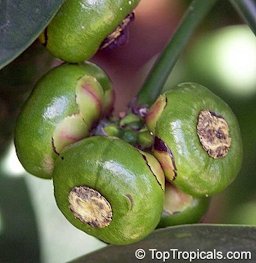 Fig. 10  Fruit habit 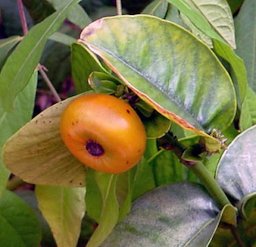 Fig. 11 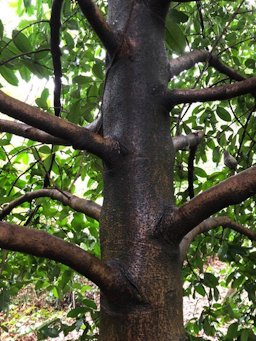 Fig. 12 G. prainiana. Malaysia |
Scientific
name Garcinia prainiana King Common names English: button mangosteen, cherapu; Malay: cerapu, cheghopu, kechupu, kecupu, mencupu 5 Synonym No synonyms are recorded for this name Relatives Mangosteen (G. mangostana); Brunei cherry (G. parvifolia); cherry mangosteen (G. intermedia); gamboge (G. xanthochymus); gourka (G. dulces); seaside mangosteen (G. hombroniana) 3 Family Clusiaceae/Guttiferae (St. John’s wort family) Origin Indigenous to the Asiatic tropics, Thailand and Malaysia 4 USDA hardiness zones Ultra tropical; will not survive the winter cold in all locations north of Key West 3 Uses Fruit; container plant Height Small to medium, 20 ft (6.1 m) in natural habitat 3 Crown Narrow, dense and bushy 6 Plant habit Evergreen; trees are dioecious, requiring both a male and a female to bear 4 Growth rate Slow growing; ideal for container growing, maintaining it at 3-6 ft (0.9-1.8 m) 3 Trunk/bark/branches Rough, greyish-brown bark; white latex 6 Pruning requirement Can easily be maintained at 3-6 ft (1-1.8 m) 3 Leaves Glossy; dark green; opposite; ovate; 2-5 in. (5-13 cm) 3 Flowers 5- petaled; red, pinkish; small but showy; dioecious 3 Fruit Round; bright orange; paper thin skin; pulp orange; lobed calyx attached to the base 3 Season July-Aug. 3 Light requirement Needs shade during juvenile stage Soil tolerances Prefers porous, deep soils; wet but welldrained; clay loams rich in organic matter 6 pH preference 5.5-6.8 6 Drought tolerance Not tolerant 3 Aerosol salt tolerance Unknown Soil salt tolerance Unknown Cold tolerance Lowest cold tolerance of all garcinias; harm 36°F (2.22°C), kill 32°F (0°C) Wind Tolerance Shelter from strong winds 3 Invasive potential * None reported Pest resistance Few pests or diseases 3 Known hazard None Reading Material The Mangosteen Alternative, Archives of the Rare Fruit Council of Australia Cherapu Slow to Germinate, Tropical Fruit News RFCI There are over 250 Garcinia species, mostly from southeast Asia. Garcinia species from the Americas were once classified as Rheedia, but now all are considered Garcinia. Sorting Garcinia Names, Multilingual Multiscript Plant Name Database, University of Melbourne, Australia ext. link Origin Indigenous to the Asiatic tropics, Thailand and Malaysia 4 Description Deep within the verdant rainforests of Borneo, Cherapu Garcinia prainiana plants begin a most ancient of rituals. Amidst the dense foliage, small red flowers emerge like jewels from the deep green branch tips, effusing their sweet aroma in hopes of seducing tiny insects. Beneath the tropical sun, the insects flitter playfully among the male and female blooms, unwittingly pollinating their thankful hosts. The consummation is a brilliant orange fruit, Mangosteen; a queen is born, and the circle of life continues. 2 The Cherapu is the most cold sensitive of the Garcinias. The species is nevertheless suitable for growing as a container plant and can be moved indoors when frost threatens. It produces an outstanding fruit, approximating the flavor of its revered but ultra-tropical cousin, the Mangosteen. For Florida growers who yearn for fresh Mangosteen, the Cherapu presents a respectable alternative. 3 Leaves The button mangosteen has similar foliage to the mangosteen, with attractive dark green, shiny leaves about 8 inches long by 4 inches wide, the undersides pale green with prominent veins. The base of each leaf appears to wrap around the branch, as if it had no petiole. 4 Flowers The beautiful rose-colored, camellia-like flowers of both sexes are about 1½ inches wide. Because both appear so much alike, it takes a close inspection to see which has the pollen and is the male (Fig. 7). The bloom, which appears singly or in tight clusters, gives this Asiatic tree a highly ornamental appearance. 4 Flowers are pentamerous (sets of five), pinkish, 2 cm wide and formed in dense, round clusters on terminal shoots or on leafless lateral shoots. Male flowers have stamens in 5 bundles around a pistillode. 6 Fruit The attractive bright-orange fruit, standing out in sharp contrast to the deep-green foliage, appear from mid-summer into fall. The soft, orange-colored flesh contains two or more seeds. 4 The fruit, round in shape, measures about 1 1/2 inches in diameter. The skin is smooth, green when immature (Fig. 9,10), turning a rich orange upon reaching maturity. A lobed calyx is attached to the base. The apex is decorated by a raised, brown 'button' made up of stigma remnants. The thin rind contains between 4 and 8 segments of fragrant , orange flesh of pleasant, subacid flavor. Fruiting takes place when the plant attains a height of about 3 feet. 3 Harvesting The fruit should be clipped from the branch when fully colored, leaving a short stub of stem protruding from the calyx. 3 Pollination Remember, you need two plants, a male and a female. By taking a pollen-bearing male flower and rubbing it onto a female, fruit set almost never fails. The two sexes are easy to tell apart by their blooms. The female has no pollen, while the male has a heavy ring of highly visible pollen circling its center. Otherwise, these beautiful flowers, which usually come in clusters, look identical in size, shape and color. 1 Some growers graft a male branch onto a female tree to aid in pollination. 3 Propagation The seeds, as with many Garcinia species, can be very slow to germinate, and may take 2-6 months to germinate. Culture The great advantage of the G. prainiana over the G. mangostana is that it can fruit at a young age after reaching thirty-six inches in height. When winter cold arrives simply pick it up in its three -gallon container and bring it indoors until the weather moderates. 1 Fertilizing A complete slow-release fertilizer should be applied at 3 or 4 month intervals. 3 Irrigation The cherapu needs regular watering. Pests/diseases Few pests or diseases affect the cherapu in Florida. Red-banded thrips are an occasional problem. 3 Food Uses It is best eaten out of hand. The bitter rind should be discarded. Fruits are also used as food flavouring and to make jams.The fruit can be stored for about a week at room temperature and can be stored for up to 2 weeks in the refrigerator. 3,6 General The Garcinia prainiana was introduced to Florida by William Whitman in 1980. 1 The cherapu is a species fro the dedicated enthusiast. at a minimum, the plant requires adequate cold protection, hand pollination (the presence of a male plant), shelter from strong winds, and regular watering. 3 Other Edible Garcinia species: Achachairu, G. humilis Bacuripari, G. macrophylla Bakupari, G. brasiliensis Gamboge (false mangosteen), G. xanthochymus Imbe (African mangosteen), G. livinstonei Lemon Drop Mangosteen, G. intermedia Madrono, G. madruno List of Growers and Vendors |
| Bibliography 1 Whitman, William F. Five Decades with Tropical Fruit, A Personal Journey. Stuart, Quisqualis Books in cooperation with Fairchild Tropical Garden, 2001. 2 "Lovers in the Pavilion: Cherapu, Garcinia prainiana." Fairchild Tropical Botanic Garden Virtual Herbarium, www.virtualherbarium.org/tropicalfruit/Cherapu.html. Accessed 29 Jan. 2015. 3 Boning, Charles. Florida's Best Fruiting Plants- Native and Exotic Trees, Shrubs, and Vines. Sarasota, Pineapple Press, 2006. 4 Whitman, William F. "The Mangosteen Alternative." Archives of the Rare Fruit Council of Australia, Extract from Tropical Fruit World. Vol.1. Mar. 1990, rfcarchives.org.au. Accessed 31 Mar. 2017. 5 "Garcinia prainiana." Malaysia Biodiversity Information System, MyBIS, www.mybis.gov.my/sp/37627. Accessed 5 May 2021. 6 Lim T. K. "Garcinia prainiana." Edible Medicinal And Non-Medicinal Plants: Volume 2, Fruits, EPDF, 2012, epdf.pub/volume-2-fruits.html. Accessed 5 May 2021. Photographs Fig. 1 Jaitt, Oscar. "Garcinia prainiana, cross Section." Fruit Lovers, www.fruitlovers.com. Accessed 29 Jan. 2015. Fig. 2 "Garcinia prainiana." Fairchild Tropical Botanic Garden, fairchildgarden.org. Accessed 29 Jan. 2015. Fig. 3 Jaitt, Oscar. "Garcinia prainiana, fruit Interior." Fruit Lovers, www.fruitlovers.com. Accessed 29 Jan. 2015. Fig. 4,12 Bonnet, Pierre. "Garcinia prainiana King. Malaysia." Pl@ntNet, 16 Dec. 2019, GBIF, (CC BY-SA 4.0), www.gbif.org/occurrence/2644283644. Accessed 5 May 2021. Fig. 5,6,9,10 "Garcinia prainiana." Top Tropicals, toptropicals.com/catalog/uid/garcinia_prainiana.htm. Accessed 29 Jan. 2015. Fig. 8 Zona, Scott. "Garcinia prainiana cultivated, Fairchild Tropical Botanic Garden, Miami, Florida, USA." Flickr, 21 July 2004, (CC BY-NC 2.0), www.flickr.com. Accessed 31 Mar. 2017. Fig. 11 Hind, Christopher. "Cheparu. Bill Whitman Tropical Fruit Pavilion at Fairchild Tropical Botanic Garden." Wikimedia Commons, 2005, Public Domain, commons.wikimedia.org. Accessed 27 Jan. 2015. * UF/IFAS Assessment of Non-native Plants in Florida's Natural Areas ** Information provided is not intended to be used as a guide for treatment of medical conditions. Published 27 Jan. 2015 LR. Last update 12 Dec. 2023 LR |
|